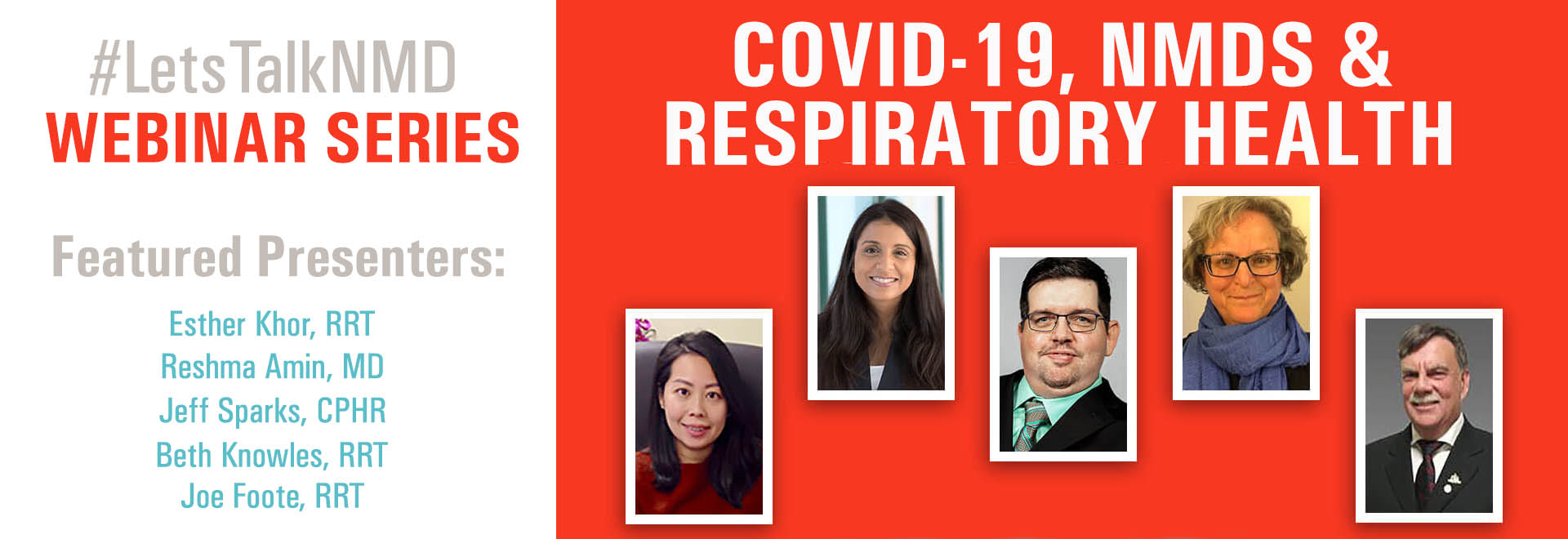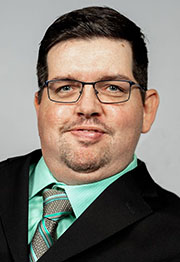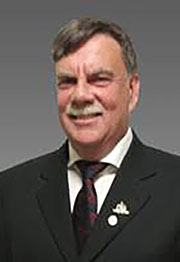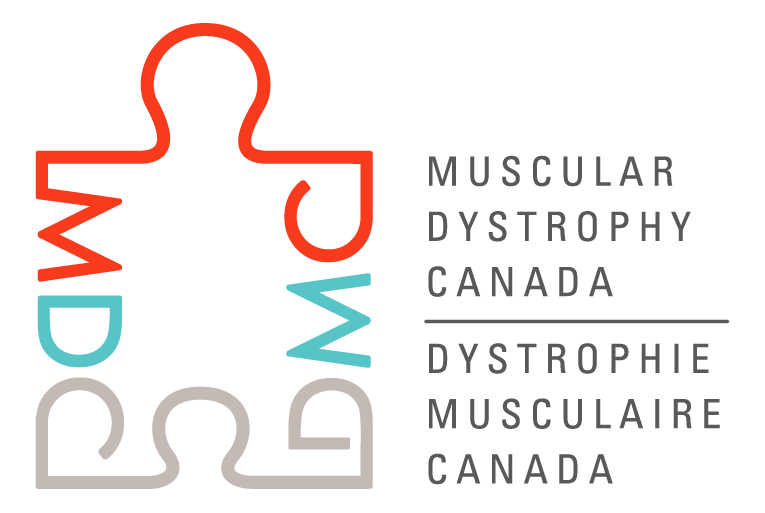
Neuromuscular Disorders, Respiratory Health & COVID-19
Learning Objectives
- Learn about respiratory-specific recommendations for people with neuromuscular disorders during COVID-19.
- Learn about pulmonary hygiene that can help keep airways and lungs clear, and prevent breathing problems.
- Learn advice on how to develop an emergency care plan that addresses respiratory needs.
- Opportunity to ask lung specialists questions about COVID-19 and neuromuscular disorders.
Presenters
ESTHER KHOR, RRT, Technology For Living – Manager of Respiratory Services, Provincial Respiratory Outreach Program (PROP) – (British Columbia):
 Esther Khor is a Registered Respiratory Therapist. Her career started in the hospital supporting patients with respiratory distress or on life support. She currently manages the Provincial Respiratory Outreach Program (PROP) in Vancouver, BC. PROP provides respiratory support for individuals needing ventilation and opting to live independently at home. She works closely with the users of the program who have neuromuscular conditions. Esther is also currently the co-chair for the Canadian Home Ventilation Network. It is a network of Home Ventilation Programs from different provinces working together to promote continuity of care from the hospitals and into the home.
Esther Khor is a Registered Respiratory Therapist. Her career started in the hospital supporting patients with respiratory distress or on life support. She currently manages the Provincial Respiratory Outreach Program (PROP) in Vancouver, BC. PROP provides respiratory support for individuals needing ventilation and opting to live independently at home. She works closely with the users of the program who have neuromuscular conditions. Esther is also currently the co-chair for the Canadian Home Ventilation Network. It is a network of Home Ventilation Programs from different provinces working together to promote continuity of care from the hospitals and into the home.
RESHMA AMIN, MD, Hospital for Sick Children (Ontario):
 Dr. Reshma Amin is Pediatric Respirologist, Sleep Physician and Director of the Long-term Ventilation Program at SickKids. She is an Associate Professor at the University of Toronto and an Associate Scientist, Child Health and Evaluative Sciences at the SickKids Research Institute. Her clinical and research interests include the respiratory complications of children with Neuromuscular Disorders as well as children using Long-term Mechanical Ventilation at home.
Dr. Reshma Amin is Pediatric Respirologist, Sleep Physician and Director of the Long-term Ventilation Program at SickKids. She is an Associate Professor at the University of Toronto and an Associate Scientist, Child Health and Evaluative Sciences at the SickKids Research Institute. Her clinical and research interests include the respiratory complications of children with Neuromuscular Disorders as well as children using Long-term Mechanical Ventilation at home.
JEFF SPARKS, CPHR, Muscular Dystrophy Canada (New Brunswick):
 Jeff Sparks is the Director of Volunteer Engagement and Human Resources. Jeff was diagnosed at 10 months of age with Spinal Muscular Atrophy Type 2. In addition to his background as a Chartered Professional in Human Resources and his current senior leadership role at MDC, at one time, Jeff operated his own consulting firm focusing on diversity in the workplace, as well as a personal care attendant agency and an accessible transportation service, is a strong self-advocate, role model and volunteer for several organizations advocating with and raising awareness about those with disabilities. Jeff has been faced with many emergency and intensive healthcare situations where he has had to advocate for his needs and is pleased to share his experiences in emergency situation planning.
Jeff Sparks is the Director of Volunteer Engagement and Human Resources. Jeff was diagnosed at 10 months of age with Spinal Muscular Atrophy Type 2. In addition to his background as a Chartered Professional in Human Resources and his current senior leadership role at MDC, at one time, Jeff operated his own consulting firm focusing on diversity in the workplace, as well as a personal care attendant agency and an accessible transportation service, is a strong self-advocate, role model and volunteer for several organizations advocating with and raising awareness about those with disabilities. Jeff has been faced with many emergency and intensive healthcare situations where he has had to advocate for his needs and is pleased to share his experiences in emergency situation planning.
BETH KNOWLES, RRT, Stan Cassidy Centre for Rehabilitation (New Brunswick):
 Beth has been a respiratory therapist for 32 years. She was a hospital based therapist for more than 20 years where she worked in Critical Care, Neonatal ICU, Emergency Room, Cardiac Care, Paediatrics and Adult Surgical and Medical units. She also has additional training in Tobacco Cessation. For the past 5 years she has worked at the Stan Cassidy Centre for Rehabilitation where she works with Adult and Paediatric patients with Spinal Cord Injuries and Neuromuscular Disease. She takes part in ALS and NMD Clinics (Adult & Paediatrics) and is part of the in-patient multidisciplinary team where she is primarily responsible for patients with complex respiratory needs. Beth provides clinical training for Respiratory Therapy students and provide workshops and training in Respiratory Management of Spinal Cord Injury and NMD for practicing Respiratory Therapists.
Beth has been a respiratory therapist for 32 years. She was a hospital based therapist for more than 20 years where she worked in Critical Care, Neonatal ICU, Emergency Room, Cardiac Care, Paediatrics and Adult Surgical and Medical units. She also has additional training in Tobacco Cessation. For the past 5 years she has worked at the Stan Cassidy Centre for Rehabilitation where she works with Adult and Paediatric patients with Spinal Cord Injuries and Neuromuscular Disease. She takes part in ALS and NMD Clinics (Adult & Paediatrics) and is part of the in-patient multidisciplinary team where she is primarily responsible for patients with complex respiratory needs. Beth provides clinical training for Respiratory Therapy students and provide workshops and training in Respiratory Management of Spinal Cord Injury and NMD for practicing Respiratory Therapists.
JOE FOOTE, RRT, CD:
 Joe is a registered respiratory therapy. He worked in intensive care, emergency, trauma and hospital wards before moving into private practice respiratory home care. He began his own respiratory home care company in 1997. As President and CEO of Quality Respiratory Care, he provides the governance and stewardship to the company, maintaining excellence in clinical care and service, and providing care to clientele to people across New Brunswick.
Joe is a registered respiratory therapy. He worked in intensive care, emergency, trauma and hospital wards before moving into private practice respiratory home care. He began his own respiratory home care company in 1997. As President and CEO of Quality Respiratory Care, he provides the governance and stewardship to the company, maintaining excellence in clinical care and service, and providing care to clientele to people across New Brunswick.
Talk Takeaways
- Depending on your type of neuromuscular condition, different respiratory muscles (inspiratory, expiratory, airways) weaken differently. Muscle weakness can often lead to muscle fatigue, which can contribute to shallow breathing and/or nocturnal hypoventilation. If infected with COVID-19, individuals with neuromuscular conditions are (theoretically) susceptible to further challenges with oxygenation.
- COVID-19 is mainly spread through droplets produced by coughing or sneezing. Non-invasive ventilators and airway clearance devices (cough assist, nebulizer) can “aerosolize” the COVID19 virus – spreading it much more widely. Home mask interfaces are vented and can blow virus out of the CO2 exhalation ports, spreading the virus in the surrounding environment, as do masks with a high leak. Risk of infection transmission is very high with these. Switching to a double-lumen limb circuit and non-vented full-face mask with a compatible ventilator can help to restrict viral spread. In addition, routine surface cleaning of respiratory equipment is important.
- Because COVID-19 is caused by a novel/new virus, we need data to truly understand its impact on neuromuscular disorders. We need data: To understand whether people with neuromuscular disorders are at an increased risk for COVID-19; To determine whether COVID-19 can cause a neuromuscular disorder; To determine if COVID-19 can exacerbate a known or unknown a previously unknown NMD. Until then, if someone with a neuromuscular disorder has any of the following factors, they are considered to be at moderate to high risk for COVID-19: respiratory complications, cardiac complications, difficulty swallowing, taking steroids and/or undergoing immunosuppressant treatment, diabetes, obesity, at risk of decompensation during infection (e.g. mitochondrial disease) and at risk of rhabdomyolysis with fever/ infection. It is very important for all individuals impacted by neuromuscular disorders to stay in contact with their neuromuscular clinicians during this time: Many clinicians offer virtual visits and tele-visits to help monitor your symptoms/care, provide guidance and ensure compliance and continuity in your care and treatment plan.
- Data from China and the U.S. demonstrates that children are much less affected than adults, especially older adults. Children infected with COVID-19 fare better than adults. Could this be because more immature immune systems respond differently to the virus? Or, there is greater density of angiotensin-converting enzyme 2 (ACE2) on lung cells (can provide a role for protection against severe lung injury). Or, children get more viral illnesses and the production of antibodies may help build immunity.
- Put a personal preparedness plan together. Have an emergency/intensive care plan binder and to go kit ready for an emergency situation. It can include advanced medical directive, specific personalized details on your care and need, alternate communication options/devices, resources and information about your specific disorder, and equipment to bring to the hospital. Here are some resources that might be helpful when you are putting together your emergency care plan:
Additional Resources
- Guide to Respiratory Care for Neuromuscular Disorders (MDC)
- Anesthetics Guide (MDC)
- Emergency Care Card (MDC)
- How To Health Guide (Health Charities Coalition of Canada)
- Going to the Emergency Room (MDA)
- My Health Passport (Sick Kids)
